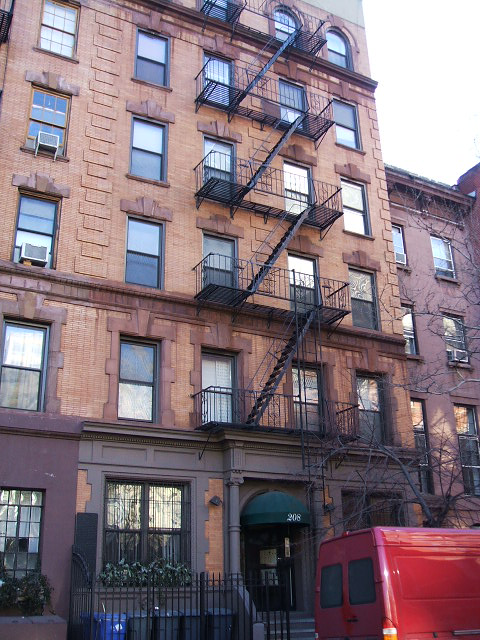Emma Goldman, “The Most Dangerous Woman in America”
A remarkable number of people and places in Greenwich Village, the East Village, and NoHo played important roles in the move towards women’s suffrage. These neighborhoods were long centers of political ferment and progressive social change, and women and men here played a prominent part in removing barriers to women voting in New York State (which didn’t grant women the right to vote until 1917) and the country. In honor of the centennial of the passage of the 19th Amendment, Village Preservation has created a StoryMap that chronicles the impact our neighborhoods and its residents had to ensure the right to vote for women.

Today, we highlight one of the entries from our StoryMap, Emma Goldman, an outspoken anarchist whom the FBI and J. Edgar Hoover called “the most dangerous woman in America.”
EMMA GOLDMAN — 208 EAST 13TH STREET
Emma Goldman was born in Kovno, Lithuania in 1869. By the time she was 23 years old, she was a divorced American citizen under arrest. For everything from being associated with anarchists to “inciting a riot” in Union Square, Emma Goldman served her time. This was just the first of many arrests for this rabble-rouser, once labeled by the FBI as “the most dangerous woman in America,” which eventually led to her deportation.
Goldman was a fierce advocate for full equality for women, including the terms of access to the franchise, but she kept her distance from the women’s suffrage movement because she fundamentally disagreed with the premise that expanding the vote would change the foundational flaws of our government. As a tried-and-true anarchist, she wanted to tear down the system completely, rather than reform it.

While she was here, this intrepid woman lived at 208 East 13th Street in the East Village and made big waves in almost every social justice movement around in the late 1800s and early 1900s. The 1910s found Goldman immersing herself in the movements for feminism, free speech, free love, birth control, and the eight-hour workday, among other battles. It took only 14 days of the new decade to see Goldman back behind bars. She was arrested on January 14, 1910, on charges of conspiracy against the government. The case was dropped on January 28th. Goldman was arrested six times in Denver, Cheyenne, Wyo., San Diego, Seattle, Portland, and New York’s Union Square again on charges of “peddling bills without a license,” distributing birth control literature, and conspiracy to violate the Draft Act between 1910 and 1917.

Goldman’s arrest in Union Square on February 11, 1916, was a result of her outspoken campaign for legalized birth control, believing that contraception was essential to women’s social, sexual, and economic freedom. It would take almost another 50 years before the FDA approved legalized birth control pills. This work drew attention from partners in the movement such as Margaret Sanger and Helen Keller, and foes in law enforcement and government.

The 1917 Espionage Act further complicated matters, setting penalties of up to twenty years imprisonment and fines of up to a $10,000 for persons aiding the enemy, interfering with the draft, or encouraging disloyalty of military members. It also criminalized all written material advocating treason, insurrection, or forcible resistance to the law. Later that year, Goldman and a comrade were arrested in New York again on conspiracy charges.

She was found guilty and given the maximum sentence — two years in prison and $10,000 fine. Judge Julius Mayer recommended her deportation as an “undesirable alien.” Goldman was still in prison when she was served with her last arrest warrant, which included a deportation order, on September 12, 1919. When she was released from prison, she was immediately detained at Ellis Island on December 5, 1919. Despite many appeals and fundraising efforts, Goldman was deported on December 21, 1919, and along with 248 other ‘radical aliens,’ set sail on the S.S. Buford, bound for Russia.

Goldman continued her work internationally, but her heyday of arrests and rabble-rousing in New York was over. In 1939 Goldman moved to Canada, where she died, in Toronto, in 1940. She was buried in Chicago near the Haymarket martyrs who first inspired her in 1887.
Village Preservation is seeing landmark designation for this and other buildings in the East Village to honor and protect their special history. To urge city officials to support landmark designation, click here.
Emma Goldman is just one of over two dozen people, places, and organizations featured on our 19th Amendment Centennial StoryMap, including labor leaders like Rose Schneiderman; temperance advocates like Frances Willard; cultural radicals like Marie Jenney Howe; and early proponents of women’s suffrage like Thomas Paine.
Explore our interactive map further and learn more about Greenwich Village, the East Village, and NoHo’s invaluable contributions to the cause of women’s suffrage.
